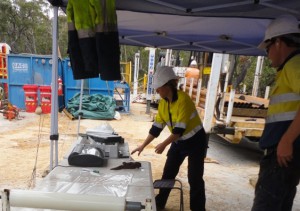
Katarina David (left) of the UNSW Connected Waters Initiative preserves samples of moist rock at a drilling site near Sydney for later testing in the laboratory. Image by UNSW
University of New South Wales (UNSW) researchers have used a new water-tracing technology in the Sydney Basin of Australia for the first time to determine how groundwater moves in the different layers of rock below the surface. The study provides a baseline against which any future effects on groundwater from mining operations, groundwater abstraction, or climate change can be assessed.
The study, which appears in the Dec. 2015 issue of the journal Science of the Total Environment, has global relevance as well “because this new technology provides a quick and cheap alternative to having to install numerous boreholes for groundwater monitoring,” said study author Wendy Timms of the UNSW Connected Waters Initiative (CWI).
The research team used a 300-m-deep (984-ft-deep) core drilled through the layers of sandstone and claystone at a site on the Illawarra plateau. Small sections of the moist rock from the core were then preserved carefully and analyzed in the UNSW laboratory.
“The best tracer of water is water itself,” said CWI Director and Professor Andy Baker. “So we directly analyzed the groundwater in the pores of the rock from different depths and rock types, using the latest laser technology.”
The researchers identified where the water came from based on different isotopes of hydrogen and oxygen in the water.
The technique is advantageous because hundreds of rock samples from a single core can be analyzed quickly and cheaply. It also can be used for sites where the groundwater is very deep or held tightly in the pores of the rock.
Researchers found that, despite the fact that water moves very slowly underground, the isotopic composition of deep water was similar to that of modern rainfall. This means the system in the Sydney Basin has been relatively stable for thousands of years, Baker said.
Using their study as a baseline, the researchers can detect any future changes in water flow or water quality.
All underground engineering projects have the potential to affect groundwater, said study author and doctoral candidate Katarina David, who also is with CWI. “So it is essential we understand how the water falling on the surface finds its way to the aquifers deep underground.”
According to David, this is especially important beneath wetlands and sensitive ecosystems and in the southern Sydney basin where six underground coal mines operate within Sydney’s water supply catchment.




